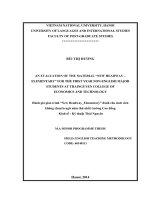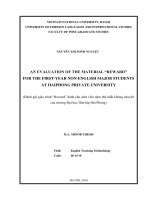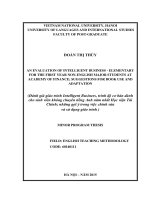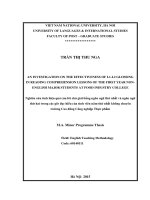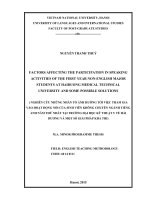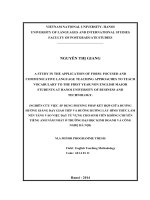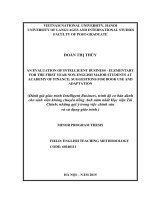(Luận văn thạc sĩ) an evaluation of intelligent business elementary for the first year non english major students at academy of finance; suggesions for book use and adaptation
Bạn đang xem bản rút gọn của tài liệu. Xem và tải ngay bản đầy đủ của tài liệu tại đây (1.01 MB, 80 trang )
VIETNAM NATIONAL UNIVERSITY, HANOI
UNIVERSITY OF LANGUAGES AND INTERNATIONAL STUDIES
FACULTY OF POST-GRADUATE
ĐOÀN THỊ THỦY
AN EVALUATION OF INTELLIGENT BUSINESS - ELEMENTARY
FOR THE FIRST YEAR NON-ENGLISH MAJOR STUDENTS AT
ACADEMY OF FINANCE; SUGGESTIONS FOR BOOK USE AND
ADAPTATION
(Đánh giá giáo trình Intelligent Business, trình độ cơ bản dành
cho sinh viên không chuyên tiếng Anh năm nhất Học viện Tài
Chính; những gợi ý trong việc chỉnh sửa
và sử dụng giáo trình )
MINOR PROGRAM THESIS
FIELD: ENGLISH TEACHING METHODOLOGY
CODE: 60140111
HÀ NỘI – NĂM 2015
VIETNAM NATIONAL UNIVERSITY, HANOI
UNIVERSITY OF LANGUAGES AND INTERNATIONAL STUDIES
FACULTY OF POST-GRADUATE
ĐOÀN THỊ THỦY
AN EVALUATION OF INTELLIGENT BUSINESS - ELEMENTARY
FOR THE FIRST YEAR NON-ENGLISH MAJOR STUDENTS AT
ACADEMY OF FINANCE; SUGGESTIONS FOR BOOK USE AND
ADAPTATION
(Đánh giá giáo trình Intelligent Business, trình độ cơ bản dành
cho sinh viên không chuyên tiếng Anh năm nhất Học viện Tài
Chính; những gợi ý trong việc chỉnh sửa
và sử dụng giáo trình )
MINOR PROGRAM THESIS
FIELD: ENGLISH TEACHING METHODOLOGY
CODE: 60140111
SUPERVISOR: Assoc. Prof. Dr. NGUYỄN VĂN ĐỘ
HÀ NỘI – NĂM 2015
DECLARATION
I hereby state that I, Doan Thi Thuy, being an M.A candidate of the Faculty of
Postgraduate, University of Languages and International studies, Vietnam National
University, Hanoi certify my authorship of the thesis submitted today entitled:
“An Evaluation of Intelligent Business – Elementary for the first year nonEnglish major students at Academy of Finance; Suggestions for book use and
adaptation”
The thesis is the study of my own work and substance of the thesis has not, wholly
or in part, been submitted for a degree to any other universities or institutions.
Hanoi, October, 2015
Doan Thi Thuy
i
ACKNOWLEDGEMENTS
In my exploring of knowledge and in the course of completing this thesis, many
individuals have assisted me. I would like to acknowledge wholeheartedly their
assistance, cooperation and encouragement which all contributed to make this study
completed. This thesis would not have been feasible without their guidance and help
of which in one way or another rendered their valuable assistance during the whole
process of carrying out and completing this study.
First and foremost, I would like to express my utmost gratitude to my supervisor,
Assoc. Prof. Dr. Nguyen Van Do for his precious guidance and constructive
criticism from the start of my work. He has constantly provided me with
encouragement and support. I would not have made steady progress without his kind
support. It is an honor for me to have his guidance as a supervisor to complete my
thesis.
Second, I owe special thanks to the first year non-English major students at
Academy of Finance for their enthusiastic participation throughout my research.
Without their patience, cooperation and attention, this study could have never been
completed.
I also wish to thank all my colleagues at Academy of Finance who are the subjects
of my thesis for their willingness to answer the questionnaire and interview. Without
their help, I could not have finished the thesis.
Last but not least, I also owe a deep debt of gratitude to my beloved friends and
family members for their unfailing encouragement and valuable support until the
completion of this research.
ii
ABSTRACT
Course books have played an important role in most language programs. However,
they are not always professionally designed and do not always fit the curriculum
and closely correspond with the objectives of the course and the needs of the
students. Within this regard, the thesis was conducted with the aims to evaluate the
suitability of the material “Intelligent Business Elementary” for the first year nonEnglish major students at Academy of Finance to investigate the suitability of the
course book to the students’ needs and interests, then to suggest practical
recommendations for future improvements of the material. The data collection
instruments employed in this study were questionnaires for teachers and students,
and informal teachers’ interviews. In this thesis, the material is analyzed based on
the criteria proposed by Hutchinson & Waters (1987). After investigating some
strengths and weaknesses of the material, the author comes to the conclusion that
the material well responds to students’ needs and interests.
Thanks to the findings, suggestions would be given for better application of the
material through adaptation techniques like addition, deletion, replacement, and
reorder and combination.
iii
LIST OF FIGURES AND TABLES
No
Title
Page
Figure
Materials Evaluation Process (Hutchinson and Waters 1987, p98)
10
Need analysis jigsaw
15
Teachers’ and students’ assessment of the book Intelligent
27
1
Figure
2
Figure
3
Figure
4
Figure
5
Table 1
Business Elementary
Teachers’ and students’ opinions about the topics in Intelligent
32
Business Elementary
Participants’ opinions about the update information of the topics
32
in Intelligent Business Elementary
Teachers and students’ opinions of the language point available
29
in Intelligent Business Elementary
Table 2 The teachers and the students’ opinion about proportion of 4
macro-skills
iv
31
TABLE OF CONTENTS
DECLARATION………………………………………………………………..…...i
ACKNOWLEDGEMENTS ……………………………………………………......ii
ABSTRACT………………………………………………………………………..iii
LIST OF FIGURES AND TABLES…………………………………………....…..iv
TABLE OF CONTENTS…………………………………………………………....v
PART A: INTRODUCTION .................................................................................1
1. Rationale of the thesis ...........................................................................................1
2. Aims of the thesis ..................................................................................................1
3. The significance of the thesis ................................................................................2
4. Scope of the thesis ................................................................................................2
5. Methods of the study .............................................................................................2
PART B: DEVELOPMENT ..................................................................................4
CHAPTER 1: LITERATURE REVIEW .............................................................4
1.1. Materials and course book .................................................................................4
1.1.1. Definitions .......................................................................................................4
1.1.2. The roles of materials......................................................................................5
1.2. Material evaluation ............................................................................................5
1.2.1. Definition ........................................................................................................6
1.2.2. Types of materials evaluation .........................................................................6
1.2.3. Purposes and importance of materials evaluation...........................................7
1.2.4. Material evaluators..........................................................................................8
1.2.5. Models for Materials evaluation .....................................................................9
1.2.5.1. Evaluation by Ellis (1997) ...........................................................................9
1.2.5.2. Evaluation by Hutchinson and Waters (1987) .............................................10
1.2.5.3. Evaluation by McDonough and Shaw (1993)..............................................11
1.2.6. Criteria for Materials evaluation .....................................................................11
1.2.6.1. Sheldon‟s Criteria ........................................................................................12
1.2.6.2. Hutchinson and Waters‟ Criteria .................................................................12
1.2.7. Need analysis .................................................................................................13
1.3. Materials adaptation ...........................................................................................15
1.3.1. Purposes of materials adaptation ....................................................................16
1.3.2. Techniques for adaptation ...............................................................................16
1.4. Previous Researches on Materials Evaluation ...................................................18
v
1.5. Suitability of the present study in the research area ..........................................20
CHAPTER 2: RESEARCH METHODOLOGY .................................................21
2.1. Description of the context ..................................................................................21
2.1.1. The setting .......................................................................................................21
2.1.2. Course material ...............................................................................................22
2.1 3. Course objectives ............................................................................................24
2.1.4. Course assessment ..........................................................................................24
2.2. Research methodology .......................................................................................24
2.2.1. Subjects ...........................................................................................................24
2.2.2. Instruments ......................................................................................................25
2.2.3. Methods and procedures .................................................................................26
CHAPTER 3: DATA ANALYSIS AND RESULTS DISCUSSION ...................27
3.1. Data analysis ......................................................................................................27
3.1.1. Comments on the course book Intelligent Business Elementary....................27
3.1.2. The Appropriateness of the Material to the Course Objectives ......................28
3.1.3. The Appropriateness of the Contents ..............................................................29
3.1.4. Teachers‟ suggestions for the materials improvement ...................................33
3.2. Summary of major findings ...............................................................................36
3.3. Recommendation for future material improvements .........................................36
3.3.1. Why teachers have to adapt the book .............................................................37
3.3.2. Adaptation Techniques ...................................................................................37
3.3.2.1. Addition .......................................................................................................37
3.3.2.2. Deletion ........................................................................................................38
3.3.2.3. Replacement .................................................................................................38
3.3.2.4. Reorder or combination ...............................................................................39
PART C: CONCLUSION ......................................................................................40
1.The Conclusion of the study ..................................................................................40
2.Limitation and suggestions for future research......................................................41
REFERENCES ........................................................................................................43
APPENDICES............................................................................................................I
vi
PART A: INTRODUCTION
1. Rationale of the thesis
It is said that there are many factors leading to the success of the teaching and
learning a foreign language which can be divided into internal and external ones.
Internal factors are those that the individual language learner brings with him or her
to the particular learning situation such as students‟ age, personality, motivation,
experience, etc. And external factors are those that characterize the particular
language learning situation including curriculum, instruction, culture and status and
so on. Course book choice is directly related to those factors with strong effects on
the entire process of obtaining a foreign language.
According to Richards (2001:35), course books are a key component in most
language programs. They may provide the basis for the content of the lessons, the
balance of skills taught and the kinds of language practice the students take part in.
Therefore, “textbook should be carefully evaluated and selected before being used
for a language program. Textbook evaluation helps the managerial and teaching
staff select the most appropriate materials available for a particular course. It also
helps to identify the strengths and weaknesses of a particular textbook that is
already in use” (Minh 2007).
At Academy of Finance (AOF), the course book Intelligent Business, Elementary
began to be used for the first year non-English major two years ago instead of
Business Basics at the same level, but no evaluation or consultation has been
conducted before applying it at AOF to determine its strengths and weaknesses and
to see how well it suits the desired and attainable goals of the course.
For all above reasons, the author has decided to choose the topic “An Evaluation of
Intelligent Business - Elementary for the first year non-English major students at
Academy of Finance; Suggestions for book use and adaptation.”
2. Aims of the thesis
This thesis aims at evaluating the course book Intelligent Business Elementary by
getting both teachers and students‟ opinions. Then it recommends some adaptation
1
so that the book can meet the students‟ needs and interests. These proposed
questions help to achieve the aims of the thesis.
(a) How does Intelligent Business Elementary satisfy students‟ needs and interests?
(b) What recommendations should be made to the material to meet the students‟
needs and interests?
3. The significance of the thesis
The results of the thesis may help the researcher, the teachers and the first year nonEnglish major students at Academy of Finance to have a deep understanding about
the course book so as for them to have suitable adaptation and to use the book more
effectively in the future. In addition, the author does hope that the study will make
some contributions to the field of material evaluation in general.
4. Scope of the thesis
Firstly, the thesis will focus on evaluating the post use of the course book Intelligent
Business Elementary for the first year non-English major students at Academy of
Finance. Secondly, due to the limitation of the minor thesis, the course book will be
evaluated in terms of language providing and skills developing.
5. Methods of the study
In this thesis, the author employs both quantitative and qualitative approaches. To
get answer for quantitative approach, there are survey questionnaires for both the
teachers and the students. In addition, teachers‟ informal interviews are used to
collect data according to qualitative approach.
Survey – questionnaires: are designed for both teachers and the first-year non
English major students who have experienced the book to collect their ideas on the
material.
Teachers’ informal interviews: are conducted with the author‟s colleagues who
also teach the material to seek for detailed and objective opinions and their
suggestions for better book uses.
2
6. Design of the study
There are three main parts in this thesis: Introduction, Development, and
Conclusion.
Part I comprises the rationale, the aims, the significance, the scope, and the design
of the study.
Part II consists of three chapters
Chapter 1: Literature Review presents a theoretical background related to materials
evaluations such as definitions, purposes, and types of materials evaluation,
materials evaluators, models for materials evaluation, criteria for materials
evaluation, as well as material adaptation.
Chapter 2: Methodology includes a brief background about English teaching and
learning at Academy of Finance, research methods, and the data collection
procedures.
Chapter 3: Results and Discussion shows the findings of data analysis and some
recommendations.
Part III: Conclusion gives a brief summary of what discussed in the study and
suggestions for further research.
3
PART B: DEVELOPMENT
CHAPTER 1: LITERATURE REVIEW
This chapter gives a brief overview of the literature relevant to the research.
1.1. Materials and course book
1.1.1. Definitions
Materials:
According to Brian Tomlinson (2005), materials are anything which is used by
teachers or learners to facilitate the learning of a language like cassettes, videos,
CD-Roms, dictionaries, grammar books, readers, workbooks or photocopied
exercises as well as newspapers, food packages, photographs, live talks by invited
native speakers, instructions given by a teacher, tasks written on cards or
discussions between learners. In other words, anything which is deliberately used to
increase the learners‟ knowledge and or experience of the language are all called
materials.
In Richards (2001:251) definition: “Materials can be instructional, experiential,
elicitative, and exploratory, in that they can inform learners about the language, they
can provide experience of the language in use, they can stimulate language use or
they can help learners to make discoveries about the language for themselves”.
There are so many kinds of materials that teachers will have a wide range of options
to choose different sources of input to help their students learn the most effectively.
Course book:
It is essential to give a good definition of course book and its characteristics so as to
do book evaluation in the most correct and suitable way. A course book is a book
which provides the core materials for a course. It aims to provide as much as
possible in one book and is designed so that it could serve as the only book which
the learners necessarily use during a course. Such a book usually includes work on
grammar, vocabulary, pronunciation, functions, and the skills of reading, writing,
listening and speaking. Ur (1996: 183) believes that the term „course book‟ means, a
4
text book of which the teacher and each student has a copy and which is in principle
to be followed systematically as the basis for a language course.
In short, course book is a book that both teachers and students must have, and used
systematically in a course of study.
1.1.2. The roles of materials
Richard (2001) states that materials provide a basis for the content of the lesson, the
appropriate proportion of skills taught, and the type of language practice students
take part in. Furthermore, useful teaching materials provide great assistance to
inexperienced teachers or poorly trained teachers. They can serve as “a form of
teacher training” and teachers can get ideas on how to plan and teach the lesson
from the materials.
It can be seen clearly that materials provide structure and syllabus for a program.
Thanks to them, a language program has a central core and learners may receive a
syllabus that has been systematically planned and developed. Also, they help
standardize instruction which means students in different classes but using the same
materials can receive similar content and therefore can be tested in the same way.
Next, they maintain quality. By using well – developed materials, students are
exposed to materials that have been tried and tested, that are based on sound
learning principles, and that are paced appropriately. In addition, they provide a
variety of learning resources. Textbooks are often accompanied by workbooks, CDs
and cassettes, videos, CDROMs, and comprehensive teaching guides, providing rich
and various sources for teachers and learners. Furthermore, they are efficient: they
save teachers‟ time, enabling teachers to devote time to teaching rather than
material‟s production. Last but not least, they can train teachers. If teachers have
limited teaching experience, a textbook together with the teachers‟ manual can
serve as a medium of initial teacher training.
1.2. Material evaluation
Deciding which textbooks to use or whether the materials being used are suitable or
not is obviously of great importance in process of learning and teaching of
5
language. And this decision can be achieved only by the means of a comprehensive
evaluation. The next part of this chapter is the review of literature of major issues in
material evaluation.
1.2.1. Definition
According to Hutchinson and Waters (1987:97), “evaluation is basically a matching
process, which concerns matching learners‟ needs to available solutions.” They also
note that evaluation is really a matter of judging the fitness of something for a
particular purpose. “Given a certain need, and in the light of the resources available,
which out of number of possibilities represent the best solution. There is no absolute
good or bad only degree of fitness for the required purpose”.
Low (1987: 21) reminds us that “teachers generally need to screen materials, in
order to predict their suitability for particular classes”. “Material evaluation is also
regarded as the systematic appraisal of the value of materials in relation to their
objectives and to the objectives of the learners using them” (Brian Tomlinson,
2005).
Brown (1995: 218) suggests that “evaluation is the systematic collection and
analysis of all relevant information necessary to promote the improvement of a
curriculum, and assess its effectiveness and efficiency, as well as the participants‟
attitudes within the context of the particular institutions involved”.
To sum up, different authors define materials evaluation in different ways. From the
writer‟s point of view, she mostly supports the idea that materials evaluation is a
matching process between the learners‟ needs and designers‟ purposes with a view
to improving the teaching-learning contexts when choosing a course book. The
definition given by Brown (1995: 218) is appreciated by the researcher.
1.2.2. Types of materials evaluation
Types of materials evaluation are classified variously. According to McGraph‟s
classification, materials evaluation includes three stages: pre-use, in-use and postuse evaluation while Robinson (1991: 59) divides materials evaluation into three
6
types: preliminary, summative and formative. These terms sound differently; in fact,
they are in common.
Preliminary or pre-use evaluation often takes place before the course starts to select
the most suitable materials for a particular group of learners and the aims of the
course.
Formative or in-use evaluation occurs during the learning process, the obtained
result can be used to modify what is being done or in other words, such results may
suggest the development of the materials later.
Summative or post-use evaluation is normally conducted when the course is
finished to decide whether the materials should continue to be used or not.
At Academy of Finance, the textbook Intelligent Business Elementary has just been
used for two years. Therefore, with the desire to investigate the book in the most
profitable way, the researcher also the teacher directly using the book has decided to
use summative or post- use evaluation to determine the effectiveness of the material
so as to offer some recommendations for further uses.
1.2.3. Purposes and importance of materials evaluation
The reason why do we need to evaluate materials is that it helps us to identify the
strengths and weaknesses of the in-use material. After being used in the classroom
for a certain period of time, teaching materials need to be evaluated to see if they
have served well in a particular teaching-learning context, and met the needs of the
students.
According to Ellis (1997), there are two primary reasons why we carry out material
evaluation. Firstly, there may be a need to choose among the materials available the
most suitable ones to use for a particular situation. Secondly, there can be a need for
materials evaluation to determine whether the material, which has been chosen,
works for that situation after it has been used for a period of time. This may help in
deciding whether to use the materials again or replace it with a better one.
Robinson (1991:112) also adds evaluation can be used as part of quality control.
Through evaluation, we can know about the advantages and disadvantages as well
7
as the effectiveness of the being used materials. Then we can decide whether the
material can be reused or whether it needs to be adapted to meet the need of the
particular teaching situation or we need to change it absolutely.
After reviewing about the purposes of materials evaluation, the importance of book
evaluation is revealed. It cannot be denied that a thorough evaluation paves the way
for teaching staff of each organization and policy makers to have an ability to
discriminate amongst all the available books in the market. After considering weak
points as well as strong points of each book, educators can choose the most
appropriate one fitting their context.
1.2.4. Material evaluators
Robinson (1991), Tomlinson (1998), Richards (2001), and Dudley-Evan & St. John
(1998) suggest that evaluators can be either outsiders or insiders.
Outsiders are those who have not been involved in the program such as consultants,
inspectors, and administrators. Accordingly, they may not fully understand the
teaching and learning situation in which the evaluation is being carried out.
Moreover, it may take them more time to be aware of the local situation such as
learners‟ needs, facilities, and time constraints so it may be difficult for them to
make truly judgments and recommendations of the program.
The insiders, in contrast, are those who have been directly involved in the languageteaching program such as teachers, students, course, materials designers. Therefore,
they can provide the most valid information in the evaluation process. In addition,
their understanding of cultural and political factors of the institution in which the
evaluation takes place would enhance the reliability of judgments and
recommendations. To stress the role of the insiders as evaluators, Richards (2001:
296) states that the involvement of the insiders plays an important part in the
success of evaluation because “as a consequence, they will have greater degree of
commitment to acting on its results”. He also adds that the teachers can watch out
for when the materials are being used. Consequently, they can know exactly the
extent that the materials work for their purposes and they make modifications to
8
improve the effectiveness of the materials. However, there are also disadvantages to
insiders when they are “too close and involved” (Dudley-Evan and St. John, 1998,
p.131) so the evaluation may be influenced by their subjective viewpoints and their
teaching experience.
1.2.5. Models for Materials evaluation
In spite of many different models for materials evaluation, the most commonly used
are those suggested by Ellis (1997), Hutchinson and Water (1987), and McDonough
& Shaw (1993).
1.2.5.1. Evaluation by Ellis (1997)
In his model, Ellis suggests the practice of a detailed empirical evaluation and
focuses on evaluation at the task level with reference to its actual teaching and
learning context. The steps are as follows:
1. Choosing the task to follow;
2. Describing the task with specification of input, procedures, language activities
and outcomes;
3. Planning the evaluation with reference to the dimensions above;
4. Collecting information before, while and after the task was used, and what how
the task performed;
5. Analyzing the information collected;
6. Reaching conclusions relating to what has been discovered, and making
recommendations for the future teaching
7. Writing the report.
Ellis‟s model is a micro-evaluation .The aim of this model is to identify the match
between task planned and task in use. However, it can only be conducted when the
materials are being used in the classroom.
9
1.2.5.2. Evaluation by Hutchinson and Waters (1987)
There is a difference between Ellis‟s model and this model. If Ellis‟s model is a
micro-evaluation, this one is actually a macro-evaluation as to be shown in this
diagram:
Define criteria
On what bases will you judge
materials? Which criteria will
be more important?
Subjective
analysis
What realizations of the
criteria do you want in your
course?
Objective
analysis
How does the material
being evaluated realize the
criteria?
Matching
How far does the
material match your
needs?
Figure 1: Materials evaluation model of Hutchinson and Waters (1987:97)
There are objective and subjective analyses in a checklist and the evaluators should
supplement other important criteria in the process of evaluating. Then identifying
the evaluator‟s requirements; analyzing the material and comparing findings those
two aspects by awarding points. However, the authors also note that highest number
of points does not necessarily indicate the most suitable material as the points may
be concentrated in one area.
10
1.2.5.3. Evaluation by McDonough and Shaw (1993)
McDonough and Shaw show a combination between macro and micro evaluation.
This model includes three stages: external evaluation, internal evaluation, and
overall evaluation. The internal stage requires an in-depth look at two or more units
to examine whether claims made by the author are the one found in the internal
evaluation. The internal stage will be carried out if the external evaluation shows
that the materials are potentially appropriate. If the findings show that the materials
are inappropriate, the evaluation will be finished at the external stage.
The model proposed by Mc Donough and Shaw (1993) illustrates a logical
procedure for materials evaluation. However, the figure does not discuss the
objectives and criteria of the materials which are important to ensure the learners‟
learning success as well as teachers‟ effective teaching.
In summary, although these models vary in the processes and the purposes, all serve
to evaluate whether the set of materials is appropriate to a certain situation or group
of learners or not. The evaluator must then base on the purposes of the evaluation,
time available, facilities as well as constraints of the context in which the evaluation
takes place to decide which model to follow. In this thesis the author decided to use
the model of Hutchinson and Waters (1987).
1.2.6. Criteria for Materials evaluation
The aim of using criteria for materials evaluation is to “reach a decision regarding
what needs to be evaluated” (Tomlinson, 1998:220). This means they are the
foundation upon which evaluators depend when making judgments. Therefore, one
of the most important steps that evaluator should spend time on is defining
evaluation criteria.
According to Dudley-Evans & John (2007), criteria for materials evaluation depend
on what is being evaluated and why they need to be evaluated. Regarding criteria
for materials evaluation, in the literature many experts (Hutchinson and Waters,
1987; Sheldon, 1988; Ellis and Johnson, 1994; Wallace, 1998; Tomlinson, 2005)
11
have suggested certain sets of criteria in the forms of checklists or guidelines. These
scholars go to two main schools of evaluation: the one focuses mainly in the content
of the material with Hutchinson and Waters as representatives; the other focuses on
both the appearance and content of the materials with Sheldon as representative. In
this study, the author reviews these two schools which seem to be the most relevant
and popular to materials evaluation.
1.2.6.1. Sheldon’s Criteria
Sheldon (1988) suggests such a wide range of criteria that can be applied for almost
aspects of materials. She offers a checklist containing “key questions” for the
evaluators to find the answer when evaluating materials. They include rationale,
availability, user definition, layout/ graphic, accessibility, linkage, selection/
grading, physical characteristics, appropriacy, authenticity, sufficiency, cultural
bias, educational validity, stimulus/ practice/ revision, flexibility, guidance, and
overall value for money. As it can be seen, Sheldon states to some extent many
criteria to evaluate the materials. Most dimensions of the materials are under
investigated, which leads to some major issues. For example, layout/ graphic or
physical characteristics required to be evaluated by graphic designers or appearance
designers of the materials. As a result, evaluator needs a great deal of time and effort to
accomplish this kind of work.
1.2.6.2. Hutchinson and Waters’ Criteria
These authors suggest four main criteria for materials including the audience, the
aims, the content and the methodology:
The audience of the materials: the evaluator should obtain information about and
from learners to find out whether the materials are suitable to the student‟s age
knowledge of English, interest and so on.
Aims of the materials: the evaluator has to check if the materials match the aims and
objectives of the course.
12
Content of the materials: the evaluator has to check whether the materials language
points, macro-skills or micro-skills, and topics suit the learners‟ needs.
Methodology of the materials: the evaluator has to find out if techniques, aids,
guidance provided in the materials satisfy the learners and the teachers of the
course. In this research, the criteria suggested by Hutchinson and Waters (1987)
will be applied because of their suitability with the real circumstance at Academy of
Finance.
1.2.7. Need analysis
Need analysis (also known as needs assessment) has a vital role in the process of
designing and carrying out any language course, whether it be English for Specific
Purposes (ESP) or general English course, and
its centrality has been
acknowledged by several scholars and authors.
This term “ need analysis” according to Elaine Tarone and George Yule ( 1999),
when it has been used in the context of language instruction, has usually referred to
the collection and evaluation of information to answer the question: “ What aspects
of the language does some particular group of learners need to know?”. Mountford
(1981) offers the definition that needs can be defined as what students should be
able to do at the end of their language course or “what the user –institution or
society at large regards as necessary or desirable to be learnt from a program of
language of language instruction. Another definition given by Brindley (1981:27) is
that needs refer to wants, desires, demands, expectations, motivations, lacks,
constraints, and requirements. It is evident that course designers may take students‟
needs into consideration when designing a course.
Clearly, the role of needs
analysis in any ESP course is indisputable. For Johns (1991), needs analysis is the
first step in course design and it provides validity and relevancy for all subsequent
course design activities. Different approaches to needs analysis attempt to meet the
needs of the
learners in the process of learning a second language. Among which, a modern and
comprehensive concept of needs analysis is proposed by Dudley-Evans and St. John
13
(1998: 125) which reflects other approaches. Their concept of need analysis is as
follows:
Environmental situation - information about the situation in
which the
course will be run (means analysis);
Personal information about learners - factors which may affect the way they
learn (wants, means, subjective needs);
Language information about learners - what their current skills and language
use are (present situation analysis);
Learner's lacks (the gap between the present situation and professional
information about learners);Learner's needs from course - what is wanted
from the course (short-term needs);
Language learning needs - effective ways of learning the skills and language
determined by lacks;
Professional information about learners - the tasks and activities English
learners are/will be using English for (Target Situation Analysis and
objective needs);
How to communicate in the target situation – knowledge of how language
and skills are used in
the target situation (register analysis, discourse
analysis, genre analysis).
Today, teachers are aware of that different types of needs analyses are in close
association to complete the jigsaw of needs analysis (Figure 2).
14
Figure 2.Needs Analysis Jigsaw
As can be seen from the figure, need analyses should be the common concern of not
only ESP but also the general English because the needs of the learners play
paramount importance in any language process. Therefore, what the designers
should do is to analyze students‟ needs in order to design appropriate courses so that
students feel motivated and learn English faster and more effectively. It is clearly
that need analysis is of great importance to the effectiveness of teaching and
learning process.
1.3. Materials adaptation
Materials adaptation is a process of matching materials with the learner‟s needs, the
teacher‟s demands, and administration‟s purpose. The aim of materials adaptation is
to make the teaching materials the most appropriate in a particular teaching context
15
by making some changes. According to McDonough and Shaw (1993: 86) and
Isakovos Tsiplakides (2011:761), what we adapt depend on the following aspects:
the specific needs and experiences of their students, the general context in which the
course book will be used, language use, skills, classroom organization, and
supplementary material.
1.3.1. Purposes of materials adaptation
The purposes of adaptation are highlighted as follows:
- to make the material more suitable for the circumstances in which it is being used,
i.e. to mould it to the needs and interests of learners, the teacher‟s own capabilities
and such constraints as time, or as McDonough and Shaw (1993) put it: “to
maximize the appropriacy of teaching materials in context, by changing some of the
internal characteristics of a course book to better suit our particular circumstances”.
- to help teachers to maximize the value of the book for the benefit of their learners.
Hence they can improve it so that it is suitable for the particular situation. (Apple
and Jungck, 1990; Shannon, 1987).
1.3.2. Techniques for adaptation
There are many techniques of adaptation such as adding, omitting, replacing,
reordering or combining according to Gabrielatos Isakovos Tsiplakides (2011:761).
- Addition: Addition is an adaptation procedure which involves supplementation of
extra linguistic items and activities to make up for the insufficiency of materials.
Addition of extra materials is appropriate when the following situations are faced:
-
Areas are not covered sufficiently.
-
Texts/pictures/tasks are not provided.
-
Texts/pictures/tasks are fewer than needed.
-
Tasks are limited in scope.
-
Tasks are of limited range.
16
- Deletion: Deletion is an adaptation procedure which involves removal of some of
the linguistic items and activities which are found to be extra and unnecessary. So,
deletion is a process in which materials are taken out rather than added. Materials
should be reduced through omission when the following situations are faced:
-
Learners are clear about a language point.
-
Learners are competent in a skill.
-
There are too many tasks on a particular area/point.
-
The item/area concerned is not a priority.
-
The item/task is not well designed.
-
The item/task is not well-suited to its aim(s).
-
The topic is not appropriate for learners.
- Rearrangement/re-ordering: Rearrangement is a procedure of materials
adaptation through which different parts of a course book are arranged in a different
order or sequence. Rearrangement of materials helps to make them comparatively
more interesting and appropriate for the learner as well as the teacher. Learners may
reorder materials by:
-
Matching their aims.
-
Using a practice task for lead-in and elicitation.
-
Revising an area earlier than the course book does.
-
Comparing and contrast areas.
-
Providing thematic unity.
-
Providing an appropriate follow-up.
- Replacement: teacher may decide to replace any text or exercise which is
evaluated to be ineffective or irrelevant by a more suitable one.
Also according to McGrath (2002:1-17), the textbooks may adapt teaching material
by selecting, rejecting, adding and changing as follows:
Selection- Selection: some material may be relevant, but pressure of time makes it
impossible to include them in the lesson. In this case, we need to decide what can
most usefully be done in class and what can be set for home work. Time-consuming
17
